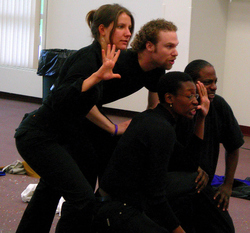Comedy: The Forgotten Art
From television to movies, comedies have only grown in popularity from year to year. Still, most people would not necessarily consider comedy to be an art form. Since it has become so popular, comedy has separated itself from what is traditionally considered art by becoming a mass produced medium. Television shows such as “Family Guy”, which became popular among the younger generations, and “The Golden Girls”, which still maintains its popularity even after being off the air for over a decade, provide the perfect examples of comedy’s mass appeal. But in order to see comedy as an art, let’s take a step back and look at comedic actors and their upbringings. There is no better place to start than Chicago with The Second City.
Chicago has been an improv and comedy hub for over 50 years. The Second City was created in 1959 and from that time to present, it has continuously produced comedy legends who went on to mainstream success–Alan Arkin, Bill Murray, and Dan Aykroyd, just to name a few. Popular television shows such as “Saturday Night Live” look at recruiting from The Second City because of the extreme talent that it nurtures and develops. This is where improv comedy took off and developed as an art. By creating a space where imaginative, comedy-inclined minds are welcomed and nourished so that they get a chance to grow, The Second City has taken improv and comedy to new levels and has solidified those art forms’ central positioning in Chicago’s arts and culture scene.
Comedy is just like any other art. It takes dedication, talent, and perseverance to grow and develop it. Writing jokes, telling jokes, and communicating with the audience are just a few of the learned skills that comedians have to develop.
Making people laugh is an art. Comedy is an art. Not everyone has the gift to make people laugh, but those that do are truly talented. Robin Williams, Joan Rivers, Bea Arthur, Tina Fey, Lucille Ball, Amy Poehler, all these people are comedic geniuses with an incredible ability to connect audience members through laughter. Comedy should be utilized more in education for this specific reason. The effects that laughter has on the body alone provide enough incentive to incorporate more laughter within education. Laughing helps to heighten positive mood, reduce stress, and increase relaxation and enjoyment.
If more comedy or laughter is incorporated in our education system, children could use these benefits to improve their school performance. With the amount of work students receive plus their extracurriculars, students can barely find time to eat and sleep, let alone have time to relax and enjoy life. Introducing more comedy into the education regimen could help relieve some of the stresses that traditionally affect students. From Urban Gateways’ perspective, relieving stress is essential, especially in many Chicago communities where students are inundated with stressors both in and out of school (gang violence is one clear example). One of our aims in teaching any art form is to help students release stress and make room for enjoyment and success, and laughter can do just that. Essentially, if laughter or humor is introduced more deeply into the education environment, students’ performance in school has the potential to improve. Bringing improv into schools could be an excellent start. Check out Urban Gateways’ touring performances by Chicago Improv Productions (pictured below) if you’re interested – The Make ‘Em Ups and Storybox Improv Theatre.
Comedy is an art form; we should utilize it to the best of our abilities and take advantage of the benefits it provides not only to children, but also to everyone. Luckily, we live in a city that offers comedy in abundance. Get out and see a show this weekend! One to mention would be The Second City Walking Tour, running through October 29, 2014, every Sunday at 10AM and Wednesday at 4PM. For more information visit The Second City’s Neighborhood Tour.

Photo of Urban Gateways Touring Group Chicago Improv Productions